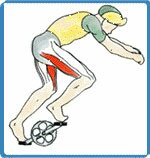|
The cycle is a tremendously efficient means of transportation. In fact cycling is more efficient than any other method of travel; including walking! The one billion cycles in the world are a testament to its effectiveness.
The engine for this efficient mode of transport is the human body. Because bodies are fueled by food, diet plays an important role in how the body performs.
Different muscle groups and types provide the power. Genetic inheritance, intensive training, and a competitive drive help top athletes push the boundaries of endurance and speed on the cycle.
How Far Do You Want To Go?
It takes less energy to cycle one mile than it takes to walk a mile. In fact, a cycle can be up to 5 times more efficient than walking.
If we compare the amount of calories burned in cycling to the number of calories an car burns, the difference is astounding. One hundred calories can power a cyclist for three miles, but it would only power a car 280 feet (85 meters)!
Bike Culture
In the UK many people still consider cycling only a recreation or professional sport. But millions of us have found that cycling is a great way to get to work or get around town. Some cyclists are banding together and forming organizations and events advocating issues important to cyclists.
The cycle has had a great impact on popular culture as well. In fashion, the cycle was largely responsible for changing women's clothing in the late 1800s. Restrictive corsets and long dresses made way for bloomers and later trousers.
In the art world, the cycle has made its way into painting and sculpture. Most notably in Marcel Duchamp's Roue de Bicyclette or Bicycle Wheel which is considered the first 'readymade' sculpture.
Fuel for Thought
Unlike cars, which require fossil fuel, cyclists are fueled by food, a renewable energy resource. The type of food a cyclist eats can affect perfomance. All of us require water, protein, carbohydrates, fats, vitamins, and minerals to stay healthy.
Fluids
The human body is made up of mostly water, so even losing as little as 2 percent of the body's fluid through sweat can adversly affect cycling performance. Athletes riding in hot conditions for extended periods need to be careful. Severe dehydration can cause heat exhaustion or heat stroke and in even in some extreme cases, death. Cyclists are instructed to drink a few cups of water before riding and then to drink often during exercise.
How Do Your Muscles Work?
A cyclist's legs provide the power for cycling. Muscle attached to the thighbone (femur) and the shinbone (tibia) do the majority of the work. Your thighbone works like a lever and if it's longer than your shinbone it will provide extra leverage on each stroke of the pedals. The length of your thighbone is determined by genetics, so if you have short thighbones you can blame your parents. The length of the thighbone is not the whole story, though, it takes muscles to move those bones.
Thousands of thin spaghetti-like fibres make up muscle tissue. These fibres receive messages from the brain, causing the fibres to contract. The main muscles at work in cycling are the quadriceps and hamstrings in the upper leg, and the gastrocnemius and soleus in the calf. These muscles contract in a sequence that creates the pedaling action.
Anaerobic vs Aerobic
It's one thing to have the brain send a message to the muscles, but what fuels the muscles during the thousands of contractions that occur during extended cycling? You've probably heard the terms aerobic and anaerobic. These terms describe two ways in which your muscles get energy.
In aerobic exercise, muscles draw on oxygen as well as the glucose and fatty acids carried in by the blood to produce adenosine triphosphate or ATP. ATP is the energy source that enables muscles to contract. The ability to keep exercising aerobically depends on the delivery of oxygen and fuel molecules (glucose and fatty acids) to your muscles. And that depends on circulation and respiration, provided by your heart and your lungs.
When exercising anaerobically, muscles are drawing on stores of glycogen (which is formed from glucose) and converting them to ATP. During this type of high-intensity exercise the muscles are producing energy without oxygen, the cardiovascular system is unable to keep up the demand. There is a price to pay for excercising anaerobically, as a waste product called lactic acid builds up. This is what causes the burning sensation in muscles and causes them to fatigue more rapidly.
Slow & Fast Twitch fibres
Every muscle is made up of two types of fibres. Fast-twitch fibres move 2 to 3 times faster than slow-twitch fibres, but they tyre more easily. Fast-twitch fibres, logically, are used for sprinting and quick ascents. Inversely, slow-twitch fibres are used for long rides of moderate intensity.
Most people have half slow-twitch and half fast-twitch fibres in their muscles. However, genetics again plays a role. Some long-distance runners have as much as 80 percent slow twitch fibres, while sprinters tend to have more fast-twitch fibres.
The Drive to Cycle
While genetics can certainly play a role in deciding whether a cyclist will be a champion or not, the drive to win and compete also has to be present. Long hours of training and intensive competition require the cyclist to be extremely determined. In addition, competitve cycling requires adherence to details and to finely tuned techniques.
People who commute by cycle or ride recreationally may not have the extreme determination that a pro cyclist has, but nevertheless cycling provides challenges and rewards to everyone who rides. Most cyclists agree that cycling not only improves their physical health but their mental outlook. A sense of accomplishment and a feeling of independence are feelings every cyclist shares. Perhaps that's why cycling for many is more than a sport or even a mode of transportation, it's a passion.
|